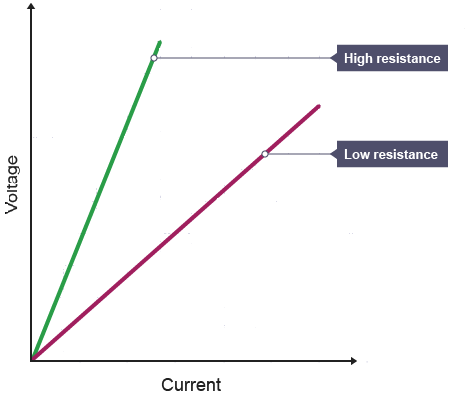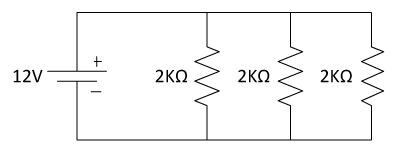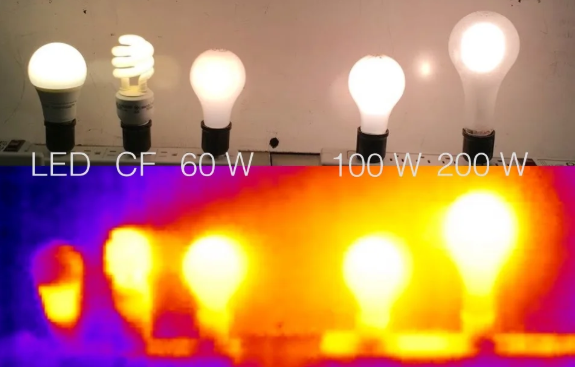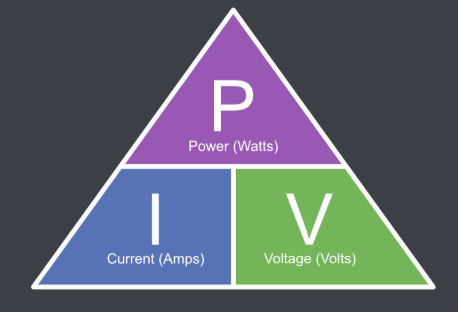We are hearing about ohm’s law from our basic grades. Also, we daily see its applications in our lives. In this article, we will try to quench all the doubts one can have related to this with more of practical approach.
In the year 1825, German physicist, Georg Simon Ohm started working on resistances. Two years later in 1827, he came out with his results and published it as a book “The galvanic circuit investigated mathematically”. Finally in 1850, Ohm’s work was considered proved and accepted as Ohm’s law.
This law tells about the relationship among voltage, current and resistance. The basic definition of ohm’s law can be given as:
“At constant physical parameters like pressure, temperature, etc., the current flowing through a conductor is directly proportional to the voltage across conductor”.
Basics of Voltage Current and Resistance
Before diving deep into the concept of Ohm’s law, let us learn the basic terminologies used in it.
Electric Voltage
Voltage across two points can be defined as the work done in bringing a charge from one point to another point. Electric potential difference, electric tension, electrical pressure are all same and is used to refer electric voltage only.
Mathematically,
V = dw/dq
So seeing this,what you think should be the unit of voltage? Common try!!
Yes, you are right! it should be joules(for work) per coulomb (for charge). And this joules per coulomb is in general called as volts. Therefore, the SI unit for voltage is volts.

Well, in your daily life you come across the word voltage many a times. Isn’t it! Try recalling (see the above fig)!! Also, do you know how much voltage do we receive at our home? Do comment if you know.
Have you ever noticed, that we are having fun with the applications it has without knowing what does it actually mean.
Haha!! Interesting right?
Electric Current
This is another term across which we come daily. It can be defined as the flow of electrons in a conductor. To make electrons flow, we need some energy (in terms of voltage).
Practically, you can imagine the flow of water (or any liquid) through the pipe. Also, you must have seen the power station. You can understand, power station as a power house of current.

Mathematically we can express current as,
i = dq/dt
i.e., flow of electric charge per unit time. So what should be the SI unit here?
Yes, its coulomb per sec which is also called as Ampere (A).
Let me ask you a question,
Do you know the voltage and current range of mobile chargers? If yes, then you know what to do, right !! Haha, yes tell me in comment section.
Electrical Resistance
Resistance is the hindrance/obstruction in the flow of electrons. The flow of current depends on both voltage and the resistance. As obviously, the more the voltage the more should be the current but the presence of resistance reduces current.
Mathematically,
R = ρ(L/A) where, ρ = electrical resistivity (ohm-metre), L = length (metre), A = area of conductor (metres square), therefore, the SI unit becomes ohm(Ω).
Practically, imagine if in the hollow pipe some stones or mud is stuck then would it affect the flow of water through it?

Yes, it will. These are called as resistances in the path flow path. One more thing to note here is that with the increase in resistance, the heat in the system will also increase.
Ohm’s Law in DC Circuits
As discussed above, at constant physical parameters the current flowing in a conductor is directly proportional to the voltage across it. Therefore, we can say that the current and voltage hold a linear relationship. That is increase in one parameter will increase the other and vice-versa.
Ohm’s Law Equation
Mathematically, the statement of ohm’s law can be written as:
V ∝ I
Now, this proportionality is replaced by a constant called resistance (R),
therefore, V = R*I
where, V = voltage across conductor (in volts)
R = Resistance of conductor (in ohm)
I = Current flowing in conductor (in amperes)
Clearly from the equation, we can see the linear relation between the voltage and the current. In your lab, you must have done experiment on ohm’s law, isn’t it?
What you observed? A linear graph or a non- linear one?
Of course, a linear one right!

The slope of above graph will give resistance value at each point.
Ohm’s Law Triangle
It is simply a way to represent and calculate the three parameters used in ohm’s law. The voltage, current and resistance all in one triangle is usually known as triangle technique of ohm’s law.

With the help of these, you can easily find out the value of one if other two are given. Isn’t it?
For instance, when current and resistance values are given, the formula remains as
V = I*R (in volts)
If resistance and voltage is given then the formula can be manipulated as
I = V/R (in amperes)
And if the values of both voltage and current are given and we need to find out resistance, the formula can be adjusted as
R = V/R (in ohms)
Examples of Ohm’s Law in DC Circuits
Let us learn all this with an example.

So, we need to calculate three things here:
- Total current in the circuit
- Individual currents in each resistor
- Equivalent resistance
We will move from last to first in order to calculate all the parameters. Therefore, the equivalent resistance in parallel is found first with the formula:
1/R = 1/R1 + 1/R2 + 1/R3
putting the values, 1/R = 1/2 + 1/2 + 1/2 = 3/2
therefore, R = 2/3 Ω
Secondly, the individual current can be find as:
I = V/R, since the voltage is same in parallel and the resistance value is also same here.
Therefore, I1 = V/R1 = 12/2 = 6 A
Similarly, I2 = I3 = 6 A.
Lastly, the total current can be found by adding all the branch currents. That is I = I1 + I2 + I3 = 6 + 6 + 6 = 18 A.
Ohm’s Law in AC Circuit
Ohm’s law in AC circuit is same other than a factor impedence which replaces resistance in DC circuit. Impedence is nothing but the AC resistance offered in the flow of current in an AC circuit.
Difference in AC & DC Resistance
The impedence (Z) has inductance and capacitance effect as well, along with the resistance. Whereas, in dc circuits only resistance is present.
One more difference we can talk about here is that in ac circuits, we use frequency while there is no frequency in dc circuits.
Equation of Ohm’s Law in AC Circuits
The equation of ohms law looks quite similar:
V = I * Z

where Z = impedence of the circuit but to calculate it we need to the inductance and capacitance values as well. Z can be expressed as:
Z = √((R^2) + j(Xl-Xc))
where, Xl = inductive reactance and is given by
Xl = 2Π(f *L)
and Xc = capacitive reactance and is expressed as:
Xc =2Π(f *C)
where, f = frequency of the system
Well, I know what is still not clear to you. You got a doubt right?
Yes, I know. The factor “j”, its nothing but a term to denote the imaginary portion of the equation. In general, j is called as ‘iota‘.
One more thing is that the knowledge of calculating inductors in series, parallel, and series, parallel of capacitance is a prerequisite.
Power Calculation
Another important factor that comes along the ohm’s law in the power calculation in both ac and dc circuits.
So, what is power? What do do you understand by this?
the muscle power!!! haha , well may be!! But believe me your brain has the best power in the world! Isn’t it?

Anyways, we are talking of the electrical power of dc circuits. This can be defined as the work done per unit time and it has a unit of watts (joule/sec).
Power Triangle
The power triangle gives the relation among power, electrical voltage and current. Equation that drive this triangle is :
P = V * I
Basically this triangle shows that if we have two values known among the three then the third one can be calculated easily.
- If voltage and current is given and power has to be calculated then the formula will be:
P = V * I (watts)
- If we have current and power value, we will find the voltage of the circuit with a manipulated formula as:
V = P / I (volts)
- If power and voltage is given then we will calculate current as :
I = P / V (amperes)
Power Rating of Resistors
Well the first question that should come to our mind is that why do we need to rate resistors?

Think!! Think !!!
The power rating tells about the maximum power that is allowable through a particular resistor. Therefore, it is a very important to calculate the rating of the resistors. Isn’t it?
Well, we will derive the rating formulas using the things that we have studied so far in this article. As we know the formulas:
P = V * I; V= I * R; I = V / R
Therefore, in case of a series circuit we know that the current is same and the voltage differs. So we can put the value of voltage in power equation to calculate the rating. That is, put V = I * R into P = V * I
P = (I * R) * I = (I^2)R
Similarly, if we have a parallel circuit then the voltages along all the branches are same and the current differs. So put the value ofcurrent in power equation:
P = V * (V / R) = (V^2) / R

Limitations of Ohm’s Law
Temperature change changes the value of resistance.
Even change in any other physical parameter will affect the resistance of the resistor.
It is valid for only bilateral elements and not for unilateral elements like diode, transistors, etc.
Also, for non- linear elements the ohm’s law is not valid. This is because for the non linear elements, the current doesn’t flow linearly and therefore, changes the resistance value in a non linear fashion. Thyristor, electric arc, etc., are few examples of it.
Applications of Ohm’s Law

- This law is used in dc measuring instruments like dc ammeter and voltmeter.
- It is used in a voltage divider circuit to divide voltage across the output resistance.
- There is one application that we use daily at our home. See the image and tell me what it is?
- Yes, right it a fan regulator. The current in the fan is regulated with the resistance in the regulator circuit.
- In various electronic circuits, there are need of voltage drop in order to achieve a particular voltage value. This is done with the help of ohm’s law.
Well, there are thousands of more applications where ohm’s law is used.
Now there is a work for you, comment the applications of ohm’s law that we use daily in our life.

